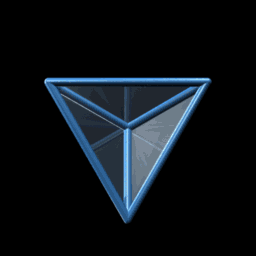|
Size: 7907
Comment:
|
Size: 10247
Comment:
|
| Deletions are marked like this. | Additions are marked like this. |
| Line 28: | Line 28: |
| # -*- coding: utf-8 -*- """ Created on Mon Feb 10 20:05:11 2014 @author: David Horgan """ from scipy.optimize import fsolve import math #scene.range = 10 #cylinder(pos=(0,0,0), radius=1.0,axis=(0,0,1), color=color.white) #scene2 = display(title='Examples of Tetrahedrons', # x=0, y=0, width=600, height=600, # center=(0,0,0), background=(1,1,1)) #scene2.visible = True #scene2.range = 10 #unit circle plot C = circle((0,0), 1) #input points from unit circle p1=0.6 p2=0.7 #face1 a1=(((1 - p2**2)/(2*(1 + p1)))**(1/4), (1/2)*(p2 + 1)*((2*(1 + p1))/(1 - p2**2))**(1/4), 0) a2=(((1 - p2**2)/(2*(1 + p1)))**(1/4), (1/2)*(p2 - 1)*((2*(1 + p1))/(1 - p2**2))**(1/4), 0 ) a3=(((1/2)*( (1 + p1)**3)* (1 - p2**2))**(1/4),p2*((2*(1 + p1))/(1 - p2**2))**(1/4), sqrt(1 - p1**2)*((1 - p2**2)/(2*(1 + p1)))**(1/4) ) a=[a1,a2,a3] #face2 b1=(0, 0, 0) b2=(((1 - p2**2)/(2*(1 + p1)))**(1/4), (1/2)*(p2 - 1)*((2*(1 + p1))/(1 - p2**2))**(1/4), 0) b3=(((1/2)*((1 + p1)**3)*(1 - p2**2))**(1/4),p2*((2*(1 + p1))/(1 - p2**2))**(1/4), sqrt(1-p1**2)*((1-p2**2)/(2*(1+p1)))**(1/4) ) b=[b1,b2,b3] #face3 c1=(0, 0, 0) c2=( ((1 - p2**2)/(2*(1 + p1)))**(1/4), (1/2)*(p2 + 1)*((2*(1 + p1))/(1 - p2**2))**(1/4), 0) c3=(((1/2)*((1 + p1)**3)*(1 - p2**2))**(1/4), p2*((2*(1 + p1))/(1 - p2**2))**(1/4), sqrt(1 - p1**2)*((1 - p2**2)/(2*(1 + p1)))**(1/4) ) c=[c1,c2,c3] #face4 d1=(0, 0, 0) d2=(((1 - p2**2)/(2*(1 + p1)))**(1/4), (1/2)*(p2 + 1)*((2*(1 + p1))/(1 - p2**2))**(1/4), 0) d3 =(((1 - p2**2)/(2*(1 + p1)))**(1/4), (1/2)*(p2 - 1)*((2*(1 + p1))/(1 - p2**2))**(1/4), 0) d=[d1,d2,d3] #printresults print 'a1=', a1 print 'a2=', a2 print 'a3=', a3 print 'b1=', b1 print 'b2=', b2 print 'b3=', b3 print 'c1=', c1 print 'c2=', c2 print 'c3=', c3 print 'd1=', d1 print 'd2=', d2 print 'd3=', d3 G = Graphics() #tetrahedron faces - coloured P1=polygon([a1,a2, a3], color='red') P2=polygon([b1,b2, b3],color='yellow') P3=polygon([c1,c2, c3],color='blue') P4=polygon([d1,d2, d3],color='green') #polygon faces #P1=polygon([a1,a2, a3]) #P2=polygon([b1,b2, b3]) #P3=polygon([c1,c2, c3]) #P4=polygon([d1,d2, d3]) #polygon([a1,a2, a3]) #polygon([b1,b2, b3]) #polygon([c1,c2, c3]) #polygon([d1,d2, d3]) g=G+P1+P2+P3+P4 show(g) show(C) |
Sage Interactions - Loop Quantum Gravity
goto interact main page
Contents

Holomorphic factorization of the Quantum Tetrahedron
by David Horgan.
Moduli Space of Shapes of a Tetrahedron with Faces of Equal Area
The space of shapes of a tetrahedron with fixed face areas is naturally a symplectic manifold of real dimension two. This symplectic manifold turns out to be a Kahler manifold and can be
parametrized by a single complex coordinate Z given by the cross ratio of four complex numbers obtained by stereographically projecting the unit face normals onto the complex plane.
This Demonstration illustrates how this works in the simplest case of a tetrahedron T whose four face areas are equal. For convenience, the cross-ratio coordinate Z is shifted and rescaled
to z=(2Z-1)/Sqrt[3] so that the regular tetrahedron corresponds to z=i, in which case the upper half-plane is mapped conformally into the unit disc w=(i-z)/(i+z). The equi-area tetrahedron
T is then drawn as a function of the unit disc coordinate w.
Reference: L. Freidel, K. Krasnov, and E. R. Livine, "Holomorphic Factorization for a Quantum Tetrahedron".
Quantum tetrahedron volume, area and angle eigenvalues
by David Horgan.
In this interact I calculate the angle, area and volume for a quantum tetrahedron The angle is found using the expression: theta = arccos((j3*(j3+1)-(j1*(j1+j1)-j2*(j2+1))/(2*sqrt(j1*(j1+j1)*j2*(j2+1)))) The area is found using the expression: A=sqrt(j1*(j1+1)) The volume is fund using the expression V^2 =M = 2/9(real antisymmetrix matrix)
Values of constants gamma is Immirzi parameter gamma =numerical_approx( ln(2)/(pi*sqrt(2))) #G = 6.63*10^-11 hbar= (1.61619926*10^-35)/(2*pi) lp is the planck length lp3=6*10^-104 Reference: Bohr-Sommerfeld Quantization of Space by Eugenio Bianchi and Hal M. Haggard. Reference: Shape in an atom of space: exploring quantum geometry phenomenology by Seth A. Major.
Research Blog: http://quantumtetrahedron.wordpress.com
Given the values of J1, J2, J3 and J4 this interact calculates the volume, area and angle eigenvalues of a quantum tetrahedron.
Quantum tetrahedron Area Operator eigenvalues
by David Horgan.
Given the values of J1, J2, J3 and J4 this interact calculates the area eigenvalues of a quantum tetrahedron.
